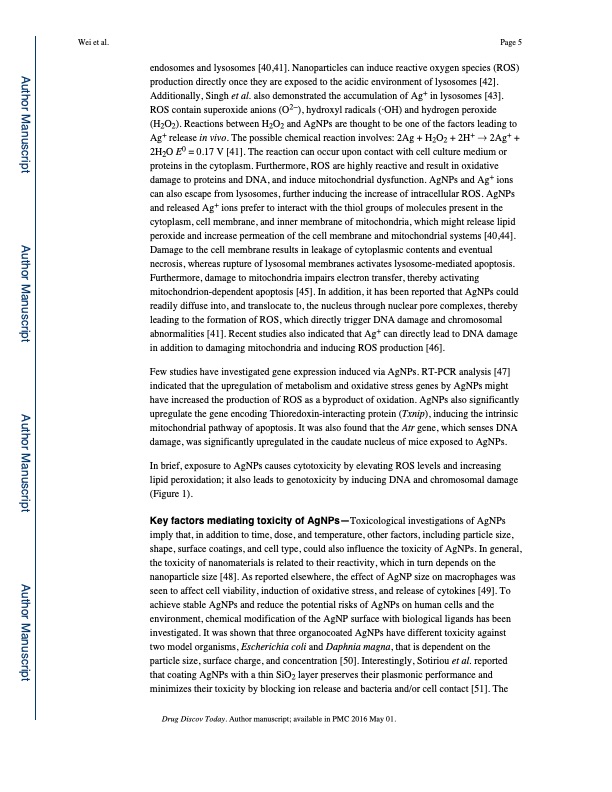
PDF Publication Title:
Text from PDF Page: 005
Wei et al. Page 5 endosomes and lysosomes [40,41]. Nanoparticles can induce reactive oxygen species (ROS) production directly once they are exposed to the acidic environment of lysosomes [42]. Additionally, Singh et al. also demonstrated the accumulation of Ag+ in lysosomes [43]. ROS contain superoxide anions (O2−), hydroxyl radicals (·OH) and hydrogen peroxide (H2O2). Reactions between H2O2 and AgNPs are thought to be one of the factors leading to Ag+ release in vivo. The possible chemical reaction involves: 2Ag + H2O2 + 2H+ → 2Ag+ + 2H2O E0 = 0.17 V [41]. The reaction can occur upon contact with cell culture medium or proteins in the cytoplasm. Furthermore, ROS are highly reactive and result in oxidative damage to proteins and DNA, and induce mitochondrial dysfunction. AgNPs and Ag+ ions can also escape from lysosomes, further inducing the increase of intracellular ROS. AgNPs and released Ag+ ions prefer to interact with the thiol groups of molecules present in the cytoplasm, cell membrane, and inner membrane of mitochondria, which might release lipid peroxide and increase permeation of the cell membrane and mitochondrial systems [40,44]. Damage to the cell membrane results in leakage of cytoplasmic contents and eventual necrosis, whereas rupture of lysosomal membranes activates lysosome-mediated apoptosis. Furthermore, damage to mitochondria impairs electron transfer, thereby activating mitochondrion-dependent apoptosis [45]. In addition, it has been reported that AgNPs could readily diffuse into, and translocate to, the nucleus through nuclear pore complexes, thereby leading to the formation of ROS, which directly trigger DNA damage and chromosomal abnormalities [41]. Recent studies also indicated that Ag+ can directly lead to DNA damage in addition to damaging mitochondria and inducing ROS production [46]. Few studies have investigated gene expression induced via AgNPs. RT-PCR analysis [47] indicated that the upregulation of metabolism and oxidative stress genes by AgNPs might have increased the production of ROS as a byproduct of oxidation. AgNPs also significantly upregulate the gene encoding Thioredoxin-interacting protein (Txnip), inducing the intrinsic mitochondrial pathway of apoptosis. It was also found that the Atr gene, which senses DNA damage, was significantly upregulated in the caudate nucleus of mice exposed to AgNPs. In brief, exposure to AgNPs causes cytotoxicity by elevating ROS levels and increasing lipid peroxidation; it also leads to genotoxicity by inducing DNA and chromosomal damage (Figure 1). Key factors mediating toxicity of AgNPs—Toxicological investigations of AgNPs imply that, in addition to time, dose, and temperature, other factors, including particle size, shape, surface coatings, and cell type, could also influence the toxicity of AgNPs. In general, the toxicity of nanomaterials is related to their reactivity, which in turn depends on the nanoparticle size [48]. As reported elsewhere, the effect of AgNP size on macrophages was seen to affect cell viability, induction of oxidative stress, and release of cytokines [49]. To achieve stable AgNPs and reduce the potential risks of AgNPs on human cells and the environment, chemical modification of the AgNP surface with biological ligands has been investigated. It was shown that three organocoated AgNPs have different toxicity against two model organisms, Escherichia coli and Daphnia magna, that is dependent on the particle size, surface charge, and concentration [50]. Interestingly, Sotiriou et al. reported that coating AgNPs with a thin SiO2 layer preserves their plasmonic performance and minimizes their toxicity by blocking ion release and bacteria and/or cell contact [51]. The Drug Discov Today. Author manuscript; available in PMC 2016 May 01. Author Manuscript Author Manuscript Author Manuscript Author ManuscriptPDF Image | Silver nanoparticles: synthesis, properties, therapeutic apps

PDF Search Title:
Silver nanoparticles: synthesis, properties, therapeutic appsOriginal File Name Searched:
nihms651778.pdfDIY PDF Search: Google It | Yahoo | Bing
Turbine and System Plans CAD CAM: Special for this month, any plans are $10,000 for complete Cad/Cam blueprints. License is for one build. Try before you buy a production license. More Info
Waste Heat Power Technology: Organic Rankine Cycle uses waste heat to make electricity, shaft horsepower and cooling. More Info
All Turbine and System Products: Infinity Turbine ORD systems, turbine generator sets, build plans and more to use your waste heat from 30C to 100C. More Info
CO2 Phase Change Demonstrator: CO2 goes supercritical at 30 C. This is a experimental platform which you can use to demonstrate phase change with low heat. Includes integration area for small CO2 turbine, static generator, and more. This can also be used for a GTL Gas to Liquids experimental platform. More Info
Introducing the Infinity Turbine Products Infinity Turbine develops and builds systems for making power from waste heat. It also is working on innovative strategies for storing, making, and deploying energy. More Info
Need Strategy? Use our Consulting and analyst services Infinity Turbine LLC is pleased to announce its consulting and analyst services. We have worked in the renewable energy industry as a researcher, developing sales and markets, along with may inventions and innovations. More Info
Made in USA with Global Energy Millennial Web Engine These pages were made with the Global Energy Web PDF Engine using Filemaker (Claris) software.
Infinity Turbine Developing Spinning Disc Reactor SDR or Spinning Disc Reactors reduce processing time for liquid production of Silver Nanoparticles.
| CONTACT TEL: 608-238-6001 Email: greg@infinityturbine.com | RSS | AMP |